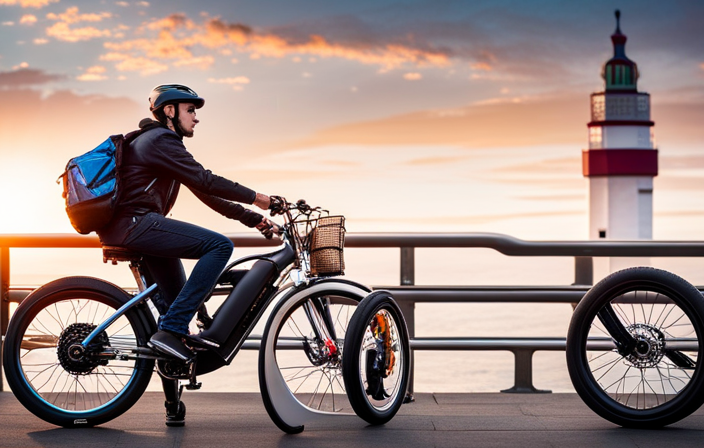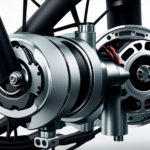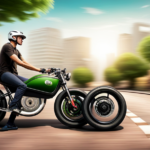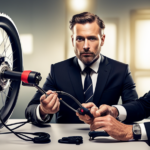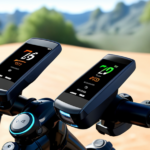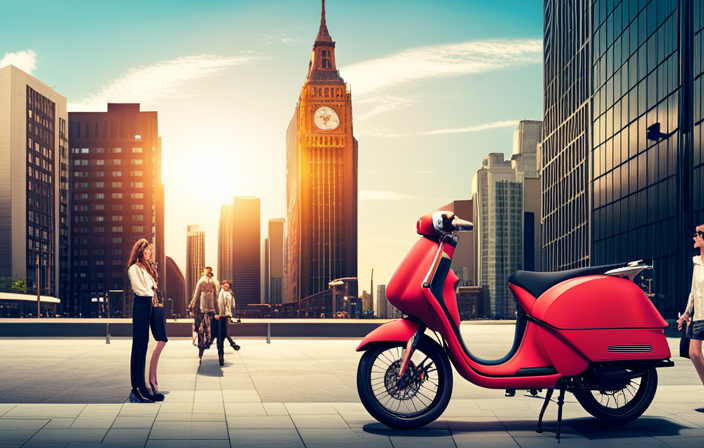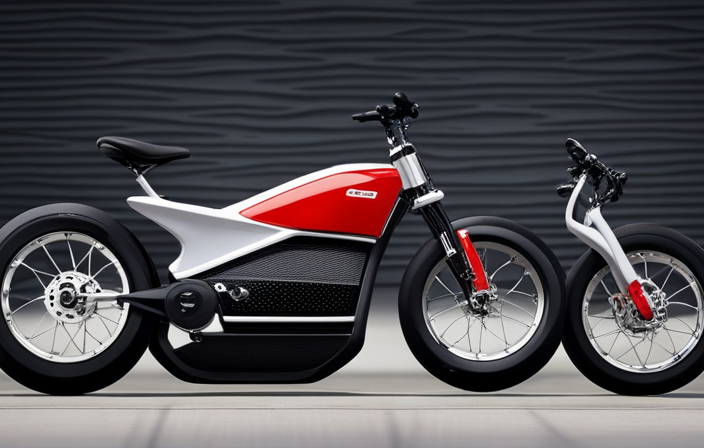As an avid electric bike enthusiast, I’ve always been fascinated by the inner workings of these incredible machines. So, you may be wondering, how do electric bike controllers work?
Well, let me take you on a journey into the technical depths of these devices. In this article, we’ll delve into the role of the controller in power regulation, how it controls speed and acceleration, the different types of controllers, and even the circuitry that makes it all possible.
Get ready to unlock the secrets behind the performance of your electric bike!
Key Takeaways
- Accurate programming and calibration are crucial for the proper functioning of electric bike controllers.
- Safety features like overload protection ensure the safety of both the rider and the controller.
- Upgrading the controller can enhance the performance of the e-bike, including acceleration, top speed, and energy efficiency.
- Troubleshooting techniques can help resolve common controller issues related to wiring, connections, and malfunctions.
Understanding the Basics of Electric Bike Controllers
Electric bike controllers are essential components that regulate the flow of electricity to the motor. These controllers play a crucial role in ensuring that the electric bike operates smoothly and efficiently.
One of the main benefits of using an electric bike controller is the ability to control the speed of the bike. With the help of the controller, riders can easily adjust the speed according to their preference and the road conditions.
Additionally, electric bike controllers also contribute to the overall performance and longevity of the bike. Proper maintenance of the controller is essential to ensure its optimal functionality. Regular inspections and cleaning of the controller can help prevent any potential issues and extend its lifespan.
Understanding the basics of electric bike controller maintenance is important in order to keep the bike running smoothly.
Moving on to the role of the controller in power regulation…
The Role of the Controller in Power Regulation
The role of the controller is to regulate the power of an e-bike. It plays a crucial role in battery management, ensuring that the power is efficiently distributed to the motor and other components.
Here are three key ways in which the controller impacts the range and efficiency of an electric bike:
-
Power regulation: The controller monitors the battery voltage and current, adjusting the power output accordingly. This helps maximize the range by preventing over-discharge or overcharge of the battery.
-
Motor control: The controller determines how much power is sent to the motor, influencing the speed and acceleration of the e-bike. By optimizing the motor control, the controller can enhance both the performance and efficiency of the bike.
-
Energy recuperation: Some controllers have regenerative braking capabilities, which allow them to recover energy during braking or coasting. This feature helps extend the range of the e-bike by converting kinetic energy into electrical energy and storing it back in the battery.
By effectively managing the power flow and optimizing motor control, the controller plays a vital role in enhancing the range and efficiency of an electric bike.
Now, let’s delve into how controllers control speed and acceleration.
How Controllers Control Speed and Acceleration
To control speed and acceleration, you’ll need to understand how controllers manage the power flow and optimize motor control.
Speed control is achieved by regulating the amount of power delivered to the motor. The controller adjusts the voltage and current supplied to the motor, allowing for precise control of its rotational speed. By varying the power input, the controller can increase or decrease the speed of the electric bike.
Acceleration control, on the other hand, involves modulating the amount of power delivered to the motor over time. This allows for smooth and gradual changes in speed, ensuring a comfortable riding experience. Controllers achieve acceleration control by gradually increasing or decreasing the power output, preventing sudden jolts or jerks.
Understanding how controllers manage speed and acceleration is crucial for optimizing the performance and efficiency of electric bikes. Now, let’s explore the different types of controllers and their functionalities.
Exploring the Different Types of Controllers
There are various types of controllers that play a vital role in managing the speed and acceleration of electric bikes. These controllers utilize different technologies to efficiently control the power flow and ensure a smooth riding experience. Let’s take a closer look at the advantages of different controller designs:
| Controller Type | Description | Advantages |
|---|---|---|
| Pedal Assist Sensor | Detects the rider’s pedaling force and adjusts the motor power accordingly. | Provides a natural and intuitive riding experience, conserves battery power, and promotes exercise. |
| Twist Throttle | Activated by twisting the handlebar grip, it provides instant and direct control over the motor power. | Offers quick acceleration and is ideal for situations that require immediate power, such as climbing steep hills. |
| Torque Sensor | Measures the applied force on the pedals and adjusts the motor power accordingly. | Provides precise control and a more natural riding experience, especially in varying terrains. |
These different types of e-bike controller technologies offer unique advantages depending on the rider’s preferences and riding conditions. Understanding these options can help riders choose the controller that best suits their needs.
Transitioning into the subsequent section about the components and circuitry of an electric bike controller, it is important to delve deeper into the inner workings of these controllers.
The Components and Circuitry of an Electric Bike Controller
Take a closer look at how the components and circuitry of an e-bike controller function to regulate the power flow and ensure a smooth riding experience.
The electric bike controller is a crucial component responsible for controlling and managing the power supplied to the motor. It consists of several key elements, including a microcontroller, power MOSFETs, and various sensors.
The microcontroller acts as the brain of the controller, processing information from the sensors and controlling the power output. The power MOSFETs are responsible for switching the power on and off, allowing the controller to regulate the power flow.
The efficiency of the controller plays a vital role in the overall performance of the electric bike, as it directly impacts the battery life. A well-designed and efficient controller can maximize the battery’s capacity and extend its lifespan.
Understanding the intricacies of the controller’s components and circuitry is crucial in optimizing electric bike controller efficiency and minimizing the impact on battery life.
The importance of proper programming and calibration cannot be overstated.
The Importance of Proper Programming and Calibration
Proper programming and calibration are essential for ensuring the efficient operation of an e-bike controller. When it comes to programming, it is crucial to use the correct settings and parameters to optimize the performance of the controller. This involves adjusting variables such as speed limits, acceleration rates, and power output to match the specific requirements of the e-bike.
Additionally, proper calibration techniques must be employed to accurately measure and interpret the signals from the various sensors and inputs. Failure to program and calibrate the controller correctly can have a significant impact on its performance and overall functionality. It can lead to issues such as reduced power output, inconsistent performance, or even complete failure.
To avoid these problems, it is vital to follow the recommended programming and calibration procedures. By doing so, the e-bike controller can operate at its full potential, delivering a smooth and efficient ride.
In the next section, we will explore the safety features and overload protection mechanisms that are integrated into modern e-bike controllers.
Safety Features and Overload Protection
Safety features and overload protection are key aspects that ensure the reliable and secure operation of modern e-bike controllers. These features are designed to prevent accidents and protect both the rider and the controller itself.
Overload prevention is achieved through various methods such as current sensors and thermal protection mechanisms. These mechanisms monitor the current flowing through the controller and can detect any excessive load that may damage the system. When an overload is detected, safety precautions are taken to prevent further damage. These precautions may include reducing the power output, limiting the current, or even shutting down the controller completely.
By implementing these safety features, manufacturers prioritize the well-being of riders and the longevity of the controller.
Now, let’s explore how enhancing the performance of your electric bike with controller upgrades can further optimize your riding experience.
Enhancing the Performance of Your Electric Bike with Controller Upgrades
To optimize your riding experience, consider upgrading your e-bike’s controller for enhanced performance. Upgrading your controller can provide several benefits, including improved acceleration, increased top speed, and better energy efficiency. By upgrading your controller, you can unlock the full potential of your electric bike and take your riding experience to the next level.
One important aspect to consider when upgrading your controller is the battery capacity. A higher capacity battery will provide more power to your motor, allowing for faster acceleration and higher speeds. Additionally, optimizing energy efficiency can help extend the range of your e-bike, allowing you to ride for longer distances without needing to recharge.
To give you a better understanding of the potential upgrades available for your e-bike’s controller, here is a table showcasing some popular options:
| Controller Upgrade | Benefits |
|---|---|
| High-performance controller | Improved acceleration and top speed |
| Programmable controller | Customizable settings for a personalized riding experience |
| Regenerative braking controller | Recharges the battery while braking, maximizing energy efficiency |
| LCD display controller | Provides real-time information on speed, battery level, and more |
Troubleshooting and Common Issues with Electric Bike Controllers
When troubleshooting common issues with e-bike controllers, it’s important to first check the wiring connections. Loose or faulty connections can cause various malfunctions in the controller, such as intermittent power loss, erratic behavior, or complete failure.
To ensure proper troubleshooting, it is essential to have a multimeter to test the voltage and continuity of the wires. Additionally, inspecting the controller for any signs of damage or overheating is crucial.
Common controller malfunctions include throttle issues, brake sensor problems, and error codes displayed on the LCD screen. By following systematic troubleshooting techniques, such as checking the battery voltage, inspecting connectors, and confirming the settings, most controller issues can be resolved.
As we look towards the future of electric bike controllers, advances and innovations in technology promise even more efficient and reliable performance without the need for constant troubleshooting.
The Future of Electric Bike Controllers: Advances and Innovations
As I explore the future of e-bike controllers, you’ll be amazed by the advances and innovations that promise even better performance and reliability.
One area that holds great promise is the innovations in battery technology. Manufacturers are constantly improving battery capacity and efficiency, allowing for longer rides and faster speeds. These advancements in battery technology will not only enhance the overall riding experience but also address one of the main concerns with electric bikes – range anxiety.
Additionally, there are exciting developments in electric bike controller technology. Intelligent controllers that can adjust power output based on rider input and road conditions are being developed. This will result in smoother acceleration, better handling, and a more intuitive riding experience.
The future of electric bike controllers is bright, and riders can look forward to an even more enjoyable and efficient riding experience.
Frequently Asked Questions
Can I use any electric bike controller for my e-bike, or do I need to find a specific one?
I cannot use any electric bike controller for my e-bike. It is necessary to find a specific one compatible with my e-bike model. Using a generic controller may have pros and cons, affecting performance and functionality.
What are the key differences between a brushed motor controller and a brushless motor controller?
The key differences between a brushed motor controller and a brushless motor controller lie in their efficiency and advantages. Brushless motor controllers offer higher efficiency, improved power delivery, longer lifespan, and reduced maintenance compared to brushed motor controllers.
How does the controller regulate power delivery to the motor based on the rider’s input?
To regulate power delivery to the motor based on the rider’s input, the controller utilizes power modulation and sensor integration. These features allow the controller to adjust the current and voltage supplied to the motor, ensuring a smooth and responsive riding experience.
Are there any safety features built into electric bike controllers to prevent overheating or electrical failures?
Electric bike controllers have safety features to prevent electrical failures and overheating. These features include thermal protection, which shuts down the controller if it reaches a critical temperature, and overcurrent protection, which safeguards against excessive current flow that can cause damage.
Can I upgrade my electric bike controller to improve the performance of my e-bike, and if so, what are the benefits of doing so?
Sure, you can upgrade your electric bike controller to enhance your e-bike’s performance. Factors to consider include compatibility, power rating, and programming options. Upgrading allows for better acceleration, increased top speed, and improved overall efficiency.
Conclusion
In conclusion, electric bike controllers are the unsung heroes behind the smooth and efficient operation of our beloved electric bikes. These ingenious devices regulate power, control speed and acceleration, and ensure the safety of both the rider and the bike.
While they may seem like simple components, their complex circuitry and advanced features are what make our electric biking experience truly exceptional. As technology continues to advance, we can only imagine the exciting innovations that lie ahead for electric bike controllers, promising an even more exhilarating and seamless ride in the future.
